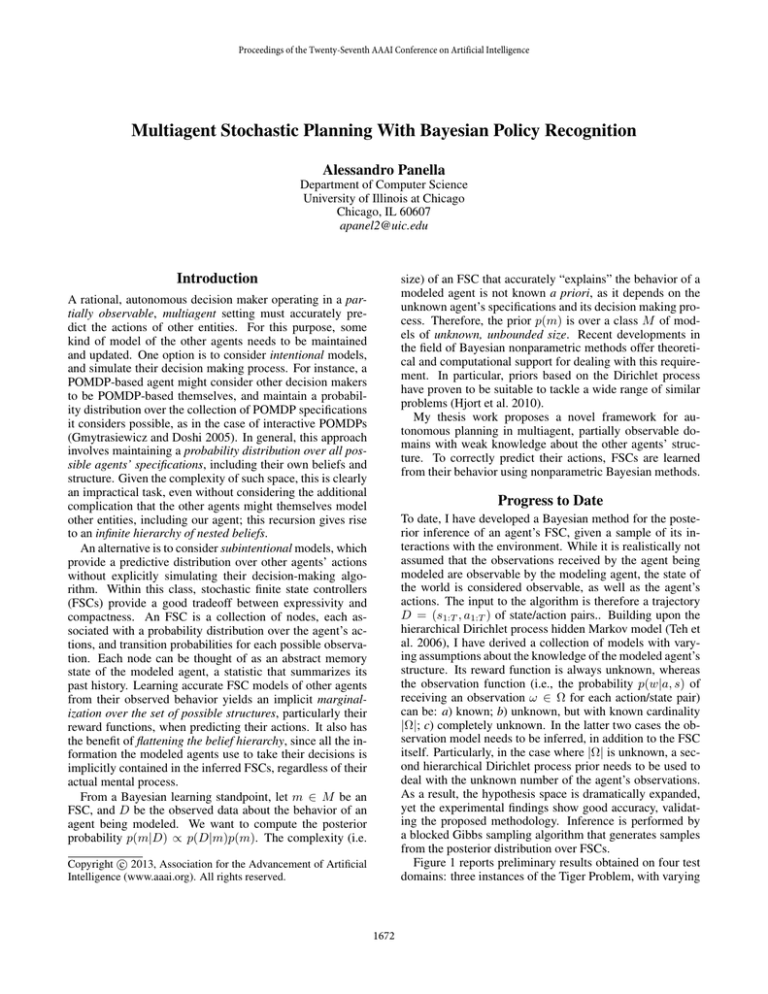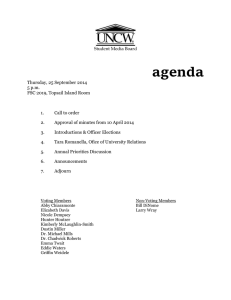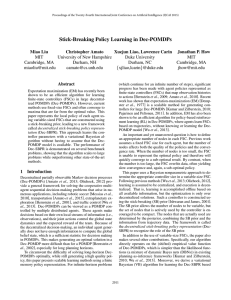
Proceedings of the Twenty-Seventh AAAI Conference on Artificial Intelligence
Multiagent Stochastic Planning With Bayesian Policy Recognition
Alessandro Panella
Department of Computer Science
University of Illinois at Chicago
Chicago, IL 60607
apanel2@uic.edu
Introduction
size) of an FSC that accurately “explains” the behavior of a
modeled agent is not known a priori, as it depends on the
unknown agent’s specifications and its decision making process. Therefore, the prior p(m) is over a class M of models of unknown, unbounded size. Recent developments in
the field of Bayesian nonparametric methods offer theoretical and computational support for dealing with this requirement. In particular, priors based on the Dirichlet process
have proven to be suitable to tackle a wide range of similar
problems (Hjort et al. 2010).
My thesis work proposes a novel framework for autonomous planning in multiagent, partially observable domains with weak knowledge about the other agents’ structure. To correctly predict their actions, FSCs are learned
from their behavior using nonparametric Bayesian methods.
A rational, autonomous decision maker operating in a partially observable, multiagent setting must accurately predict the actions of other entities. For this purpose, some
kind of model of the other agents needs to be maintained
and updated. One option is to consider intentional models,
and simulate their decision making process. For instance, a
POMDP-based agent might consider other decision makers
to be POMDP-based themselves, and maintain a probability distribution over the collection of POMDP specifications
it considers possible, as in the case of interactive POMDPs
(Gmytrasiewicz and Doshi 2005). In general, this approach
involves maintaining a probability distribution over all possible agents’ specifications, including their own beliefs and
structure. Given the complexity of such space, this is clearly
an impractical task, even without considering the additional
complication that the other agents might themselves model
other entities, including our agent; this recursion gives rise
to an infinite hierarchy of nested beliefs.
An alternative is to consider subintentional models, which
provide a predictive distribution over other agents’ actions
without explicitly simulating their decision-making algorithm. Within this class, stochastic finite state controllers
(FSCs) provide a good tradeoff between expressivity and
compactness. An FSC is a collection of nodes, each associated with a probability distribution over the agent’s actions, and transition probabilities for each possible observation. Each node can be thought of as an abstract memory
state of the modeled agent, a statistic that summarizes its
past history. Learning accurate FSC models of other agents
from their observed behavior yields an implicit marginalization over the set of possible structures, particularly their
reward functions, when predicting their actions. It also has
the benefit of flattening the belief hierarchy, since all the information the modeled agents use to take their decisions is
implicitly contained in the inferred FSCs, regardless of their
actual mental process.
From a Bayesian learning standpoint, let m ∈ M be an
FSC, and D be the observed data about the behavior of an
agent being modeled. We want to compute the posterior
probability p(m|D) ∝ p(D|m)p(m). The complexity (i.e.
Progress to Date
To date, I have developed a Bayesian method for the posterior inference of an agent’s FSC, given a sample of its interactions with the environment. While it is realistically not
assumed that the observations received by the agent being
modeled are observable by the modeling agent, the state of
the world is considered observable, as well as the agent’s
actions. The input to the algorithm is therefore a trajectory
D = (s1:T , a1:T ) of state/action pairs.. Building upon the
hierarchical Dirichlet process hidden Markov model (Teh et
al. 2006), I have derived a collection of models with varying assumptions about the knowledge of the modeled agent’s
structure. Its reward function is always unknown, whereas
the observation function (i.e., the probability p(w|a, s) of
receiving an observation ω ∈ Ω for each action/state pair)
can be: a) known; b) unknown, but with known cardinality
|Ω|; c) completely unknown. In the latter two cases the observation model needs to be inferred, in addition to the FSC
itself. Particularly, in the case where |Ω| is unknown, a second hierarchical Dirichlet process prior needs to be used to
deal with the unknown number of the agent’s observations.
As a result, the hypothesis space is dramatically expanded,
yet the experimental findings show good accuracy, validating the proposed methodology. Inference is performed by
a blocked Gibbs sampling algorithm that generates samples
from the posterior distribution over FSCs.
Figure 1 reports preliminary results obtained on four test
domains: three instances of the Tiger Problem, with varying
c 2013, Association for the Advancement of Artificial
Copyright Intelligence (www.aaai.org). All rights reserved.
1672
the Gibbs sampler and online variational inference (Bryant
and Sudderth 2012).
Reward Function Inference
An additional objective of my thesis work is to learn information about the interacting agents’ reward function. Inferring preferences is valuable because it generates transferable
knowledge that can be applied to different domains of interaction, and it can be used to build descriptive models of human and animal behavior. Reverse-engineering the reward
function of decision-theoretic agents from their behavior is
known as inverse reinforcement learning in the context of
fully observable MDPs. For POMDPs, existing approaches
assume that either the agent’s FSC is known, or its belief
trajectory is observable (Choi and Kim 2011). My objective
is to develop a methodology that does not make such assumptions, since they are often unrealistic. Two approaches
will be investigated: (a) infer the reward function from the
FSC after it is learned, and (b) learn FSC and reward function simultaneously. Combining the latter with online FSC
learning would lead to a preference elicitation methodology.
Figure 1: Action prediction error. The horizontal lines show
the best achievable accuracy. The y axis is clipped at 0.4.
sensor accuracy (0.96, 0.85, 0.8), and a navigation problem
in a 4x3 maze. Results are shown for each of the three assumptions regarding the modeled agent’s observation function, with statistics gathered over 100 runs. The training
sequences were generated from the FSCs obtained by solving the corresponding POMDP (3, 5, 7, and 44 nodes respectively.) The reported error is the proportion of incorrect
action predictions along a test sequence, where each prediction is sampled from the distribution p(at+1 |s1:t , a1:t ) computed from the inferred FSC at each timestep. The horizontal lines represent the expected least possible error in each
case, obtained by making prediction using the actual FSC
of the agent being modeled.
In addition to multiagent settings, the proposed methodology can be used in the context of apprenticeship learning,
where the goal is to generate a policy that closely imitates
the behavior of an expert, acquired through demonstrations.
I plan to submit a paper describing my progress to date to
the 2013 edition of the Conference on Neural Information
Processing Systems.
Summary and Timeline
The existing and expected contributions of my thesis can be
summarized as:
• Develop models and algorithms for offline and online
learning of finite state controllers from observing the behavior of other agents.
• Integrate such methodologies in planning algorithms.
• Building on these results, investigate techniques for the
inference of other agents’ preferences and generation of
transferable knowledge.
As a tentative timeline, I expect to design an online inference algorithm by July 2013, along with the integration in a
POMDP planner. The remaining part, and tackling emerging challenges and new directions, will be addressed in the
months to follow.
Proposed Work
Multiagent Planning and Online FSC Learning
In order to be used when acting in multiagent settings, the
learned models must be included in a planning algorithm. In
the case of POMDPs, the set of nodes of the FSC is added
to the set of states of the world of the POMDP specification.
Since the dynamics of the two sets are conditionally independent given the modeled agent’s observation, they can be
treated separately, rather than combined explicitly as in a
Cartesian product, so that the growth in complexity is attenuated. I plan to integrate FSC models in both offline and
online POMDP algorithms.
The batch learning method described above can be used
in a scenario where an observing agent passively acquires
knowledge about oblivious entities, and subsequently exploits the learned models to act optimally. Nevertheless,
other agents might recursively be modeling our agent themselves. In order to take this into consideration, the agents’
FSCs must be inferred while the interaction takes place.
With learning happening online, the modeling agent’s own
actions influence the behavior of the other entities, and
hence in turn the learning process itself. I plan to investigate the resulting dynamics as one of the contributions of
this work. Regarding the technique to be adopted for online
FSC learning, I am exploring the use of an online version of
References
Bryant, M., and Sudderth, E. 2012. Truly nonparametric online variational inference for hierarchical dirichlet processes.
In Advances in Neural Information Processing Systems 25,
27082716.
Choi, J., and Kim, K.-E. 2011. Inverse reinforcement learning in partially observable environments. Journal of Machine Learning Research 12:691730.
Gmytrasiewicz, P. J., and Doshi, P. 2005. A framework for
sequential planning in multi-agent settings. J. Artif. Int. Res.
24(1):4979.
Hjort, N. L.; Holmes, C.; Mller, P.; and Walker, S. G., eds.
2010. Bayesian Nonparametrics. Cambridge University
Press.
Teh, Y. W.; Jordan, M. I.; Beal, M. J.; and Blei, D. M. 2006.
Hierarchical dirichlet processes. Journal of the American
Statistical Association 101:1566–1581.
1673





